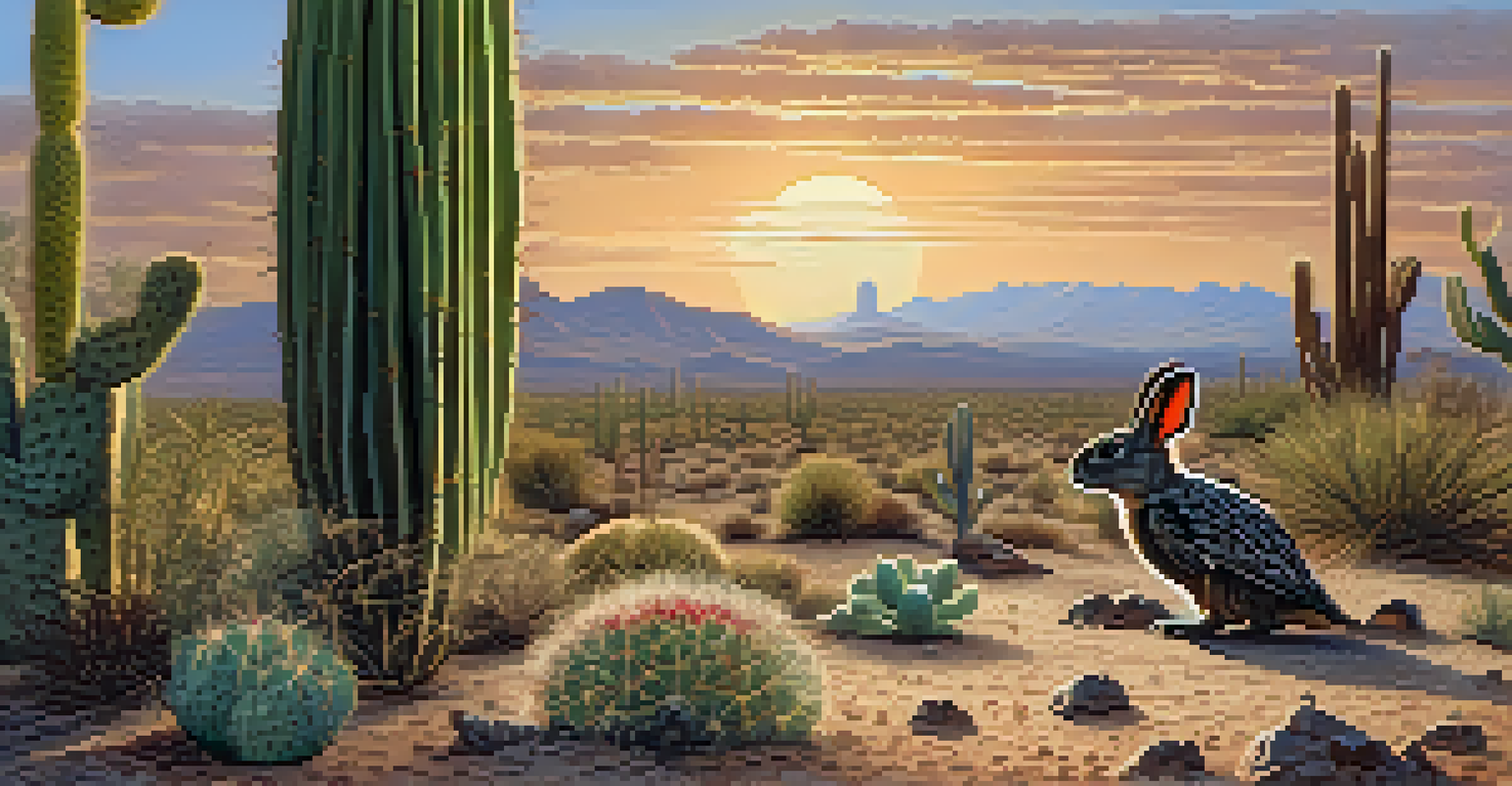The Role of Tucson's Cacti in Supporting Native Wildlife

Introduction to Tucson's Unique Ecosystem
Tucson's landscape is defined by its stunning desert environment, where cacti play a crucial role. These resilient plants have adapted to survive in harsh conditions, thriving in the Sonoran Desert. The variety of cacti species found in Tucson not only adds beauty to the scenery but also supports a diverse range of wildlife.
In every walk with nature one receives far more than he seeks.
Understanding the relationship between cacti and native wildlife is essential. Cacti provide food, shelter, and nesting sites, making them indispensable to many species. As we explore this topic, we will uncover the intricate connections between these plants and the animals that depend on them.
In this article, we will delve into the various ways cacti contribute to the ecological balance in Tucson and highlight the importance of preserving this unique desert habitat.
Cacti as a Food Source for Wildlife
Cacti are not just beautiful; they are a vital food source for numerous animals in Tucson. Many species, including birds, insects, and mammals, rely on the fruit and pads of cacti for sustenance. For example, the prickly pear cactus produces vibrant fruits called 'tunas' that are enjoyed by birds and small mammals alike.

Insects, such as bees and butterflies, are particularly attracted to the flowers of cacti, which serve as a nectar source. This interaction not only provides food for the insects but also supports the overall pollination process critical for plant reproduction. This symbiotic relationship showcases how cacti contribute to a thriving ecosystem.
Cacti Provide Vital Wildlife Support
Cacti serve as essential food and shelter for various wildlife species in Tucson, contributing significantly to the desert ecosystem.
By providing essential nutrients, cacti help sustain various wildlife populations, making them an integral part of Tucson's food web. Without these plants, many species would struggle to find adequate nourishment.
Shelter and Habitat Provided by Cacti
Cacti serve as natural shelters for many desert-dwelling creatures. The dense spines and thick pads of these plants create safe havens for birds seeking protection from predators. For instance, the Gila woodpecker often makes its home in the cavities of saguaro cacti, showcasing how these plants provide necessary nesting sites.
The environment is where we all meet; where we all have a mutual interest; it is the one thing all of us share.
Besides birds, small mammals, such as rabbits and rodents, find refuge among the cacti. The dense structures offer shade during the scorching heat and protection from harsh weather conditions. This makes cacti an essential component of the desert habitat, enabling wildlife to thrive.
As urban development encroaches on natural habitats, the importance of preserving cacti becomes increasingly evident. Protecting these plants ensures that wildlife has adequate shelter and can continue to inhabit the desert ecosystem.
Pollinators and Cacti: A Symbiotic Relationship
Cacti and pollinators share a fascinating symbiotic relationship that is crucial for both parties. The vibrant flowers of cacti are designed to attract a variety of pollinators, including bees, butterflies, and hummingbirds. In return for their nectar, these pollinators help fertilize the flowers, enabling cacti to produce seeds and fruit.
This relationship not only benefits the cacti but also supports the diets of the pollinators. For example, the presence of flowering cacti in springtime provides essential food for bees, which play a significant role in the overall ecosystem. The flourishing of these plants leads to increased biodiversity in the area.
Cacti Aid Soil Conservation
The extensive root systems of cacti help stabilize soil and retain moisture, preventing erosion and enhancing soil health.
Understanding this symbiosis highlights the importance of preserving cacti to support pollinator populations. Protecting these plants ensures the continuation of this vital ecological process.
Cacti's Role in Soil Conservation
Cacti play an essential role in soil conservation within Tucson's desert ecosystem. Their extensive root systems help stabilize the soil, preventing erosion caused by wind and rain. This is particularly important in arid environments where soil can easily be swept away, leading to degradation of the habitat.
Additionally, cacti contribute to soil health by retaining moisture. Their thick, fleshy tissues store water, allowing them to slowly release it into the surrounding soil. This moisture retention benefits other plant species and supports the overall health of the desert ecosystem.
By protecting cacti, we also safeguard the soil and ensure that it remains fertile for future generations of plants and wildlife. This illustrates how interconnected the desert ecosystem truly is.
Cacti and Climate Adaptation for Wildlife
As climate change continues to impact ecosystems, cacti provide crucial adaptation strategies for wildlife. These plants are well-equipped to thrive in extreme temperatures, offering shelter and sustenance to animals during harsh conditions. By adapting to their environment, cacti help wildlife cope with climate variability.
For instance, some species of birds have been observed nesting in cacti during droughts, taking advantage of the shade and moisture provided by these plants. This adaptability is vital for survival in a rapidly changing climate.
Conservation Efforts are Crucial
Protecting cacti through conservation initiatives is vital for maintaining the delicate balance of Tucson's desert habitats.
Preserving cacti is not just about protecting plants; it's about ensuring that wildlife has the resources needed to adapt and survive in the face of environmental challenges.
Conservation Efforts for Tucson's Cacti and Wildlife
As we recognize the vital role of cacti in supporting wildlife, conservation efforts become essential. Various initiatives focus on preserving cacti habitats, restoring degraded areas, and raising awareness about their importance. These efforts aim to protect the delicate balance within Tucson's desert ecosystem.
Local organizations and community groups often work together to promote sustainable practices that benefit both cacti and wildlife. Educational programs and volunteer opportunities help engage the public in conservation efforts, fostering a sense of responsibility towards the environment.

By supporting these initiatives, individuals can contribute to the preservation of Tucson's unique desert landscape and the myriad species it supports. Every small action counts in ensuring a thriving ecosystem for future generations.
Conclusion: The Importance of Cacti for Wildlife
In conclusion, Tucson's cacti play a multifaceted role in supporting native wildlife. From providing food and shelter to aiding in soil conservation and climate adaptation, these plants are essential to the desert ecosystem. Their intricate relationships with various species emphasize the importance of preserving these natural resources.
As urbanization and climate change threaten desert habitats, it becomes increasingly crucial to advocate for cacti conservation. By prioritizing the protection of these plants, we can ensure the survival of many wildlife species that depend on them.
Ultimately, the story of Tucson's cacti is a reminder of the delicate balance within our ecosystems and the importance of nurturing our natural environments for the benefit of all living beings.